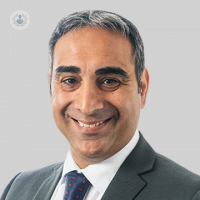Shoulder prosthesis
Mr Adrian Simons - Orthopaedic surgery
Created on: 11-13-2012
Updated on: 08-17-2023
Edited by: Sophie Kennedy
What is a shoulder prosthesis?
A shoulder prosthesis is an artificial joint that replaces your damaged shoulder joint by surgical intervention. It is usually carried out when other forms of conservative treatment haven’t worked to relieve symptoms of pain, discomfort and reduced range of movement in your shoulder. People who suffer from osteoarthritis often require a shoulder prosthesis.

Why is a shoulder prosthesis used?
The procedure is usually carried out on people who suffer from advanced osteoarthritis or severe shoulder arthritis (rheumatoid arthritis) and require a shoulder prosthesis. It can help control pain and regain lost functionality.
What does the surgery consist of?
A shoulder prosthesis is placed through a surgical intervention under general anaesthesia. The operation usually lasts about 2 hours and you will normally need to spend at most one or two days in hospital. It is occasionally carried out as a day-case.
There are two types of prostheses; the surgery of which will depend on the damage of the joint and the adjacent tendon structures that support the joint. The two types of prosthesis include an anatomical prosthesis or reverse shoulder prosthesis. Both are manufactured from metal and plastic.
Anatomical shoulder prosthesis
This type of prosthesis allows the shoulder implant to be tailored to the patient's anatomy. The ball is replaced with metal and the socket is replaced with plastic. It requires that the shoulder tendons and muscles are preserved.
Reverse shoulder prostheses
This type of prosthesis is used when the tendons around the shoulder are torn or the muscles are inadequate. A metal ball is placed where the socket used to be, and a plastic socket on a metal stem is placed where the ball used to be. This reversal of the usual anatomy allows the remaining muscle (deltoid) to work better to regain movement at the shoulder, and function in the arm.
There are other types of prosthesis models that are used, however, this depends on the underlying problem and the age of the patient. The different models include humeral surface prosthesis, anatomical total shoulder prosthesis or hemiarthroplasty of the shoulder.
Risks of surgery
Shoulder replacement is usually carried out under general anaesthesia. Risks of complications depend on your general health. Specific to the operation, the risks include:
- Infection: Generally in less than one per cent of cases, but is slightly higher in patients with diabetes or rheumatoid arthritis
- Tear of the muscles around the joint: Up to five per cent of cases, but really only relevant to patients with an anatomic shoulder replacement
- Dislocation: Up to five per cent, but mostly in patients with a reverse shoulder replacement
- Nerve injury: Perhaps in 1 in 200 cases
- Wearing out our the prosthesis: We would expect ninety-five per cent of shoulder replacements to last 10 years or more, but they do eventually wear, and may need further surgery
Preparation
The specialist will advise you what preparations to follow before surgery. They depend on the type and location of the injury, as well as your age and how previous therapies have worked. Shoulder replacement is a fairly major operation, so it is important that any other medical conditions are optimised before surgery.
Aftercare
Gentle passive exercises can start immediately after the operation, with a gradual build up in the motion of the shoulder. More intense physiotherapy will start around 6 weeks after surgery to enhance range of motion and build strength.
You can expect some postoperative pain, however, local anaesthesia is usually injected into the neck to numb the area before surgery. Therefore, when you wake up, you shouldn’t feel any intense pain as the arm will very likely still feel numb. Once the anaesthesia wears off, you will need to take some pain relievers to ensure the postoperative period is more comfortable for you.
Alternative treatments
The alternatives to undergoing a shoulder replacement are conservative treatments that aim to preserve the function and health of the shoulder joint. Before undergoing a shoulder replacement, your specialist will first try other conservative therapies and treatments, such as physiotherapy with or without injections of steroids.



